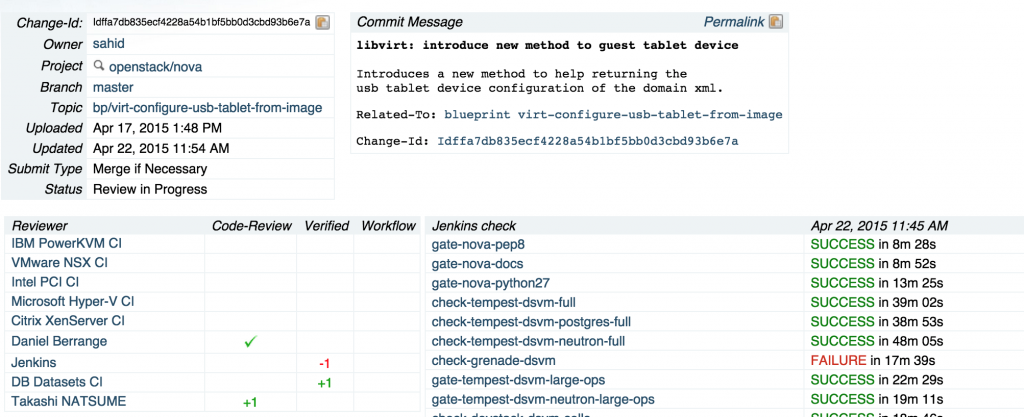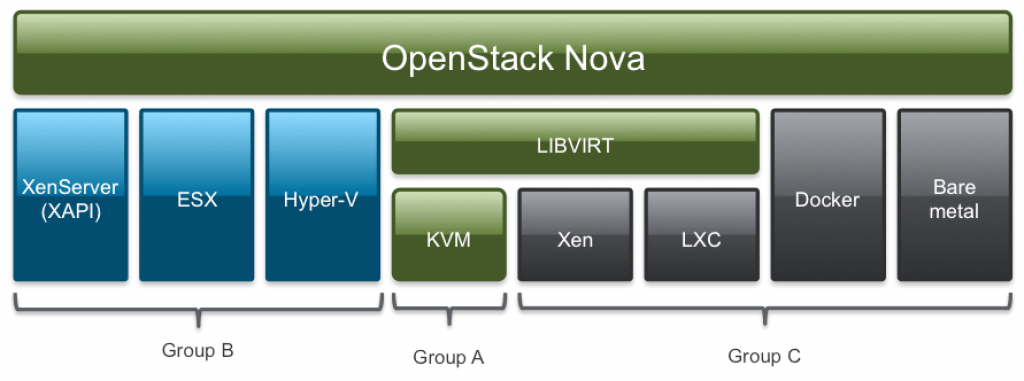We recently introduced the new Xen Project Test Lab, a key piece of infrastructure to improve the quality of our code and code coverage. As stated earlier, “we are serious and proactive when it comes to minimising and, whenever possible, eliminating any adverse effects from defects, security vulnerabilities or performance problemsâ€. This also applies to Xen Project integration with OpenStack, which is why the Xen Project Advisory Board made available funds to create the Xen Project – OpenStack CI Loop in January 2015. We started work on setting up our OpenStack CI Loop immediately after the funds were made available, fixed a number of issues in the Xen Project Hypervisor, Libvirt and OpenStack Nova and are excited to announce that our Xen Project – OpenStack CI Loop is now live and in production.
I wanted to thank members of our Test Infrastructure Working Group, comprised of employees from AMD, Amazon Web Services, Citrix, Intel and Oracle, and community members from Rackspace and Suse who have been supporting the creation of the Xen Project – OpenStack CI Loop.
What does an OpenStack CI Loop Do?
An OpenStack external testing platform (or CI Loop) enables third parties to run tests against an OpenStack environment that is configured with that third party’s drivers or hardware and reports the results of those tests on the code review of a proposed OpenStack patch. It is easy to see the benefit of this real-time feedback by taking a look at a code review that shows how these platforms provide feedback.

In this screenshot, you can see a number Verified +1 and one Verified -1 labels added by CI loops to OpenStack Nova.
The figure below, shows the number of OpenStack Nova drivers for Hypervisors, which allow you to choose which Hypervisor(s) to use for your Nova Deployment. Note that these are classified into groups A, B and C.
In a nutshell, the groups have the following meaning:
- Group C: These drivers have minimal testing.
- Group B: These drivers have unit tests that gate commits and functional testing providing by an external system that does not gate commits, but advises patch authors and reviewers of results in the OpenStack code review system.
- Group A: These drivers have unit tests that gate commits and functional testing that gate commits.
With the introduction of the Xen Project – OpenStack CI Loop we are close to achieving our first goal of moving the Xen Project Hypervisor from Group C to B. This is a goal we first publicly stated at this year’s FOSDEM’15 where some of you may had had the opportunity to hear Stefano Stabellini talk about using the Xen Project Hypervisor in OpenStack.
What we test against?
Currently, our CI Loop tests all OpenStack Nova commits against Ubuntu Xen 4.4.1 packages with a number of patches applied to them, together Libvirt 1.2.14 with a number of patches applied to them (for more details see this specification). All the patches are already integrated upstream. When off-the shelf packages of these changes are available in Linux distros, we will start testing against them.
What is next?
Monitor the CI loop test results against the official OpenStack CI: we will run the CI loop for a few weeks and monitor, whether there are any discrepancies between the results of the official Nova CI loop and ours. If there are any, we will investigate where the issue is and fix them. This is important, as we had a number of intermittent issues in the Xen Libvirt driver and we want to be sure, we have fixed them all.
Fix two known issues, and enable two disabled tests: We have two test cases related to iSCSI support (test_volume_boot_pattern), which are currently disabled. In one case, we believe the that the Tempest Integration Suite makes some KVM specific assumptions: Xen Project community members are working with the OpenStack community to fix the issue. The second issue is related, but requires further investigation.
Make the Xen Project – OpenStack CI Loop voting: The next logical step, is to work with the OpenStack community to make our CI loop voting. This is the first step to move from group C to B.
Beyond That: Build trust and become an active member of the OpenStack community. Our ultimate goal, is to ensure that the Xen Project Hypervisor moves into group A, alongside KVM. We are also investigating, whether it makes sense to run Xen Project + Libvirt against OpenStack Neutron. We are also looking at integrating OpenStack Tempest into our new Xen Project Test Lab, such that we can ensure that upstream Xen and Libvirt will work with OpenStack Nova.
Can I Help?
If you use Xen Project with OpenStack and Libvirt, feel free to get in touch. Some members of the Xen Project community will be at the Vancouver OpenStack Summit and we are keen to learn, what issues you have and whether we can help fixing them. As community manager, will help arrange meetings and build bridges: feel free to contact me under community dot manager at xenproject dot org. You can also ask questions on xen-devel@ and xen-users@ and connect with Xen Project Developers and Users.
Additional Resources
- Setting Up an External OpenStack Testing System – Part 1
- Setting Up an External OpenStack Testing System – Part 2
- Xen Project Now an Easy Option in OpenStack
- OpenStack CI Loop for Xen-Libvirt
- OpenStack Nova Hypervisor Support Matrix (Feature Comparison)
- OpenStack Nova Hypervisor Support Matrix (Quality Groups)

